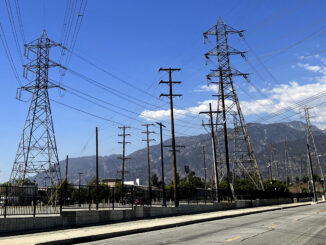
Power Consumers Become Victims of Suicidal Subsidised Wind & Solar Push
September 17, 2022 by stopthesethings 8 Comments
No country that ‘invested’ in wind and solar has ever seen their retail power prices fall. In Europe, wind and solar ‘powered’ Germans and Danes are punished by Europe’s highest power prices – around double that paid by the nuclear-powered French. Australia’s wind and solar capital, South Australia set the benchmark down under for crippling power prices years ago and its denizens still pay prices well above their coal-fired neighbours.
The relationship couldn’t be clearer (see above).
Ultimately, power consumers suffer the cost of additional transmission lines running from the back of beyond; the staggering cost of running highly-inefficient Open Cycle Gas Turbines (or diesel fuelled ship engines) to cope with total collapses in wind and solar output; and running traditional coal-fired power plants inefficiently. Those staggering and wholly unnecessary costs are all embedded in retail power bills.
The subsidies to wind and solar mean coal-fired power plants (the backbone of Australia’s grid) can’t dispatch power according to consumer demand (the subsidies allow wind and solar operators to underbid them). However, they are still directed by Federal government regulators to remain online (burning coal) so they can send power to the grid in an instant, whenever the sun sets and/or calm weather sets in – what’s called ‘spinning’ reserve.
The business model of reliable generators has been destroyed by the Federal and State government mandates, targets and massive subsidies to wind and solar; households and businesses get to carry the can.
Australia’s witless PM, Anthony Albanese he and his gormless Energy Minister, Chris Bowen have been spruiking up their plan to carpet Australia and even more wind turbines and solar panels, claiming that the result will be a veritable Nirvana; with free and abundant electricity, the likes the world has never seen.
Meanwhile, back on Earth here’s Judith Sloan.
Renewables push won’t bring down power prices soon
The Australian
Judith Sloan
13 September 2022
Last week in parliament, Anthony Albanese attempted to explain how electricity prices were determined in this country: “It is not really rocket science. You don’t need an economics degree … to know that if the market changes from a more expensive level of energy to a cheaper level of energy, you get cheaper energy prices … That is why (Australians) got solar panels on their roofs.”
It may as well be rocket science for the Prime Minister because he clearly doesn’t understand how electricity prices are set or the irrelevance of the example of the installation of small-scale solar panels by households.
It is the case that households are subsidised to install rooftop solar panels, with the precise arrangements varying from state to state. They are then further subsidised through generous feed-in tariffs for any surplus electricity that is fed back into the grid. These subventions are paid for by taxpayers and other electricity consumers without solar panels.
The households that got in early have done the best, with some of the most generous deals being grandfathered by state governments. Those that have taken up the offer to install solar panels recently have done less well. After taking account of the capital expenditure and the fact panels don’t last very long and can be unreliable, they offer a reasonable but not excessive return.
Most households with solar panels remain connected to the grid: after all, the sun goes down and there can be cloudy and wet days. While some have invested in small battery storage, this is an expensive option, although it is further subsidised in some jurisdictions such as South Australia.
Electricity retailers charge a service charge as well as a tariff based on usage. Across time, we should expect this service charge to grow proportionately as the penetration of solar panels increases further. In effect, this is the option price for customers for remaining connected to the grid. Albanese is correct that Australians have been encouraged to install solar panels because of the possibility of saving money on their bills. Where he is astray is to think this is an efficient way to reduce emissions as part of a climate change policy.
Abatement costs per tonne of CO2 are very high for these sorts of small-scale efforts relative to all other measures. And these types of subsidies are a case of Robin Hood in reverse – wealthier households with their own freestanding homes are effectively subsidised by other households, including renters and those living in apartments.
Let me return to how electricity prices are determined in the national electricity market, which links five states and the ACT. Albanese is adamant “renewables are the cheapest form of new energy” and “that we stand by our modelling”. But electricity is not like the market for most goods. Shifting up the supply curve at certain times of the day won’t necessarily reduce the overall price paid by consumers. Supply must meet demand at all times, 24 hours a day, every day. It is the marginal supplier that determines the price at any point, with suppliers bidding into the market and the operator ensuring the market clears.
What has emerged recently, as the penetration of large-scale renewable energy has risen, is large variations in the wholesale price of electricity across the day. On sunny and windy days, the price can be low, sometime negative, during the day, but the price shoots up at night when the sun sets and the wind often dies down. At this point, renewable energy is not useful and only reliable or firming generation (coal, gas, hydro) can be used to meet demand.
Another feature of the electricity market is that these diurnal variations in the price undermine the economics of firming generation, particularly coal. Because coal-fired plants operate on a continuous basis, the losses they incur during the day need to be offset by profits made at other times for them to stay in business. But with many plants ageing and the price of coal rising steeply, the likely effect of more renewable energy is to hasten the exit of plants, which puts upward pressure on electricity prices. Indeed, the higher the penetration of renewable energy, the greater the increase in prices unless new reasonably priced firming capacity quickly enters the market.
Gas-peaking plants are an obvious answer but the price of gas is high and rising.
It is why there is much discussion and some investment in large-scale batteries. The trouble is that we have not reached the point of achieving economic, long-duration batteries – they can provide power for only a few hours. Given the shortage of minerals needed for construction of these batteries, the outlook for batteries to counterbalance the inherent intermittency of renewable energy is highly uncertain.
It is also why the Snowy 2.0 project is important because it provides a substantial source of storage that can be used to firm supply. But the costs and timeline of this project have blown out and 2027 looks like the earliest starting date. While there are investigations being initiated on other possible pumped-hydro projects, they are unlikely to make any difference for years.
The federal government also is placing much store by additional investment in transmission as a way of connecting far-flung renewable energy projects to the grid and potentially adding to the reliability of renewables generation. There are numerous problems with this solution, including that regulated transmission lines earn a guaranteed rate of return for owners and the price of transmission simply flows to consumers. Transmission and distribution costs amount to 40 per cent of the retail price, with the wholesale price another 25 per cent and the remainder mainly the retail margin.
The bottom line is our Prime Minister, even with his economics degree, has a lot to learn about electricity prices. The average wholesale price in the June quarter was triple the level of a year ago and the Australian Energy Regulator predicts prices will stay high for years. Retail customers are about to be hit with much higher bills. Elsewhere, the higher the penetration of renewable energy, the higher are electricity prices: think Denmark and California.
Albanese and Energy Minister Chris Bowen quickly need to walk back from their pledge that average household electricity bills will fall by $275 a year. It also would be useful if they acknowledged that pushing more renewable energy into the system as well as subsidising unpopular new transmission lines are not magic bullets. State energy ministers should take note.
The Australian
Yep, that’s right Chris, the only way is up.



